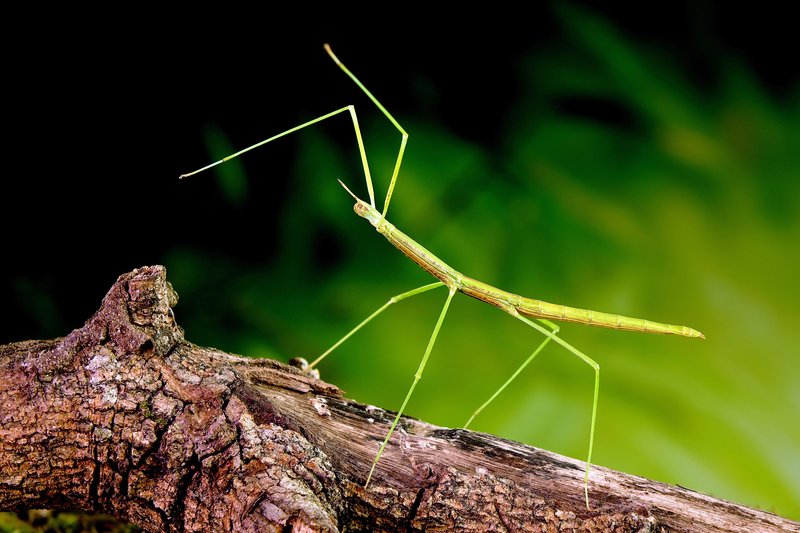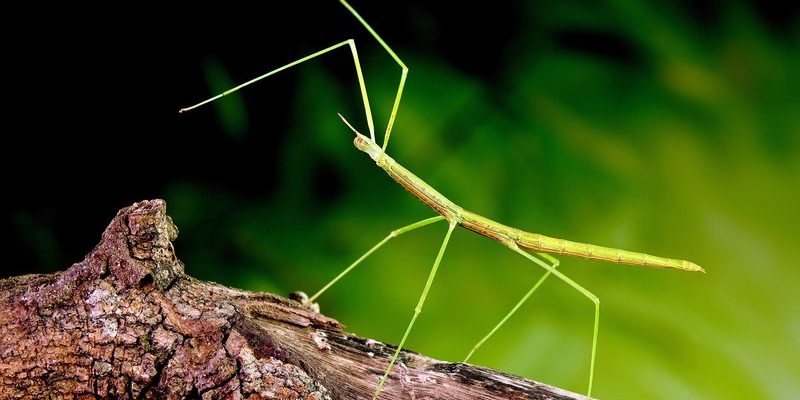
Walking Stick Insects are some of the most fascinating creatures on the planet. Often camouflaged to look like twigs or branches, they are true masters of disguise in the insect world. Imagine if you could blend into your surroundings so well that even the sharpest-eyed bird would struggle to see you—that’s life for a Walking Stick Insect!
These intriguing insects belong to the order Phasmatodea, which translates to “phantom” in Greek, perfectly capturing their ghostly, stick-like appearance. There are over 3,000 species of Walking Stick Insects, found in various habitats around the globe, particularly in tropical regions. Their body structure is long and slender, making them a perfect match for their arboreal environments. But there’s so much more to them than just their extreme camouflage!
Physical Characteristics
Walking Stick Insects can come in various sizes, ranging from just a couple of centimeters to impressive lengths of more than 30 centimeters. Their bodies are elongated and stick-like, which helps them blend seamlessly into their environments. Many species can also change color slightly, depending on their habitat, which is an interesting adaptation for survival. This incredible ability to mimic their surroundings is a key factor in avoiding predators.
Interestingly, some species have unique features such as spines or bumps that resemble the rough texture of tree bark. This not only enhances their camouflage but also offers them some protection. Female Walking Stick Insects tend to be larger and bulkier than males. While males are often lighter and more agile, it’s the females that can lay hundreds of eggs, ensuring the continuation of their kind.
Habitat and Distribution
Walking Stick Insects thrive in tropical and subtropical regions, but you can find them in a range of environments, from rainforests to temperate forests. They primarily stick to areas with plenty of foliage, as their diet mainly consists of leaves. Most species prefer to stay in the canopy, where they can remain undetected by predators.
In addition to tropical rainforests, some Walking Stick Insects have adapted to live in less lush environments, such as shrublands and woodlands. This adaptability allows them to survive in various climates, though their preference remains for warm, humid conditions. These insects are not just confined to one area; their distribution spans across continents, from Asia to Africa and even parts of the Americas.
| Size: | 2 to 30+ cm |
| Habitat: | Tropical and temperate forests, shrublands |
| Diet: | Leaves (preferably from shrubs and trees) |
| Lifespan: | 1 to 2 years |
| Colors: | Green, brown, grey (can vary by species) |
| Behavior: | Camouflage, some species can regrow limbs |
Diet and Feeding Habits
When it comes to food, Walking Stick Insects are herbivores, munching on a variety of leaves. They have a particular liking for leaves from specific plants, which they depend on for both nutrition and camouflage. Their slow, deliberate movements help them avoid detection as they feed, making it easier to remain hidden from hungry predators.
These insects possess chewing mouthparts that allow them to break down tough plant material. Interestingly, some species have been known to eat a wider range of vegetation depending on their habitat and available resources. If you ever spot one of these peculiar insects, you might also see them enjoying a leisurely meal!
Reproduction and Lifecycles
Walking Stick Insects have a fascinating reproduction process. Females can reproduce without mating in a process called parthenogenesis, which allows them to produce eggs without fertilization. This is particularly helpful in environments where finding a mate might be challenging. Each female can lay hundreds of eggs, which can sometimes resemble seeds, further aiding their camouflage.
The eggs hatch into nymphs, which look similar to miniature versions of the adults, but without the capacity for flight. As they grow, these nymphs undergo a series of molts, shedding their exoskeletons several times before reaching adulthood. The growth and transformation process is gradual and can take several months, depending on the species and environmental conditions.
Predators and Threats
Despite their effective camouflaging abilities, Walking Stick Insects are not immune to threats. Birds, reptiles, and even some mammals pose significant dangers. However, their primary defense mechanism is their ability to blend seamlessly into their surroundings. When threatened, some species can even drop to the ground and remain motionless, enhancing the likelihood of escaping detection.
Human activity also plays a role in their conservation status. Deforestation and habitat loss are significant threats to many species of Walking Stick Insects. As their natural habitats shrink, so does their chance of survival. Conservation efforts to protect these insects’ habitats are crucial for their continued existence. Creating awareness about their ecological importance will help ensure that future generations can enjoy observing these remarkable beings.
Fun Facts about Walking Stick Insects
Walking Stick Insects are not just interesting because of their appearance; they have some remarkable traits as well. For one, they belong to a group of insects known for their ability to regenerate lost limbs. If they lose a leg, they can regrow it during their next molting phase! This ability adds to their survival toolkit, allowing them to recover from encounters with predators.
Additionally, many species exhibit fascinating behaviors. Some can even mimic the movements of twigs swaying in the breeze when threatened. This behavior enhances their disguise, making it even harder for predators to spot them. Plus, in certain cultures, Walking Stick Insects are kept as pets due to their unique appearance and relatively low maintenance needs.
Walking Stick Insects are a testament to nature’s creativity and adaptability. Their ability to camouflage effectively is just one of many fascinating traits that help them thrive in the wild. As we learn more about these remarkable insects, we are reminded of the importance of preserving their habitats and ensuring their survival for years to come. So next time you’re in a forest and happen to glimpse a stick that seems out of place, take a closer look—you might just discover a hidden Walking Stick Insect!
FAQ
Are Walking Stick Insects dangerous to humans?
No, Walking Stick Insects are not dangerous to humans at all. They do not bite or sting, making them harmless. Their primary defense is their camouflage, which helps them avoid predators rather than confront them.
How can you tell the difference between male and female Walking Stick Insects?
Generally, female Walking Stick Insects are larger and bulkier than their male counterparts. Males are often smaller and more slender, which is an adaptation that allows them to be more agile. Additionally, females typically have a more robust body structure for egg-laying purposes.
Do Walking Stick Insects make good pets?
Yes, many people keep Walking Stick Insects as pets! They are relatively easy to care for, requiring minimal space and care. Just provide them with fresh leaves and a suitable habitat, and they can thrive in captivity. However, some species may have specific care requirements, so it’s essential to research before adopting one.
How long do Walking Stick Insects live?
Walking Stick Insects typically have a lifespan of about 1 to 2 years. Their longevity can be influenced by factors such as species, diet, and environmental conditions. In a well-maintained habitat, they can live closer to the upper limit of that range.
What do Walking Stick Insects eat in captivity?
In captivity, Walking Stick Insects can be fed a variety of leaves. Common food options include bramble, rose, and oak leaves. It’s important to provide fresh leaves daily and remove any uneaten portions to maintain a clean environment.
Can Walking Stick Insects fly?
Some species of Walking Stick Insects do have wings and can fly, while others are completely wingless. The presence of wings often varies based on the species and environmental adaptations. Winged species may take flight as a means of escaping predators or finding new habitats.
How do Walking Stick Insects defend themselves?
Walking Stick Insects primarily rely on their camouflage to avoid predation. By blending into their surroundings, they can escape the notice of birds and other predators. Some species may also drop to the ground or mimic twigs swaying in the breeze when threatened, enhancing their disguise.
Are Walking Stick Insects solitary or social creatures?
Walking Stick Insects are generally solitary creatures. They do not exhibit social behaviors and prefer to live alone or in small numbers. However, during mating season or when conditions are favorable, you might find them congregating in certain areas.
What is the scientific classification of Walking Stick Insects?
Walking Stick Insects belong to the order Phasmatodea. Within this order, they are divided into various families and genera, with over 3,000 species recognized worldwide. Their scientific classification highlights their close relationships with other insects and their unique adaptations for survival.
Can Walking Stick Insects regenerate lost limbs?
Yes, some species of Walking Stick Insects have the ability to regenerate lost limbs. If an insect loses a leg during an encounter with a predator, it can regrow that limb during its next molting phase. This remarkable ability aids their survival in the wild.
What role do Walking Stick Insects play in their ecosystem?
Walking Stick Insects play an essential role in their ecosystems as herbivores. By feeding on leaves, they help to manage plant growth and contribute to nutrient cycling. Additionally, they serve as prey for various predators, thus maintaining the balance within their habitats.

